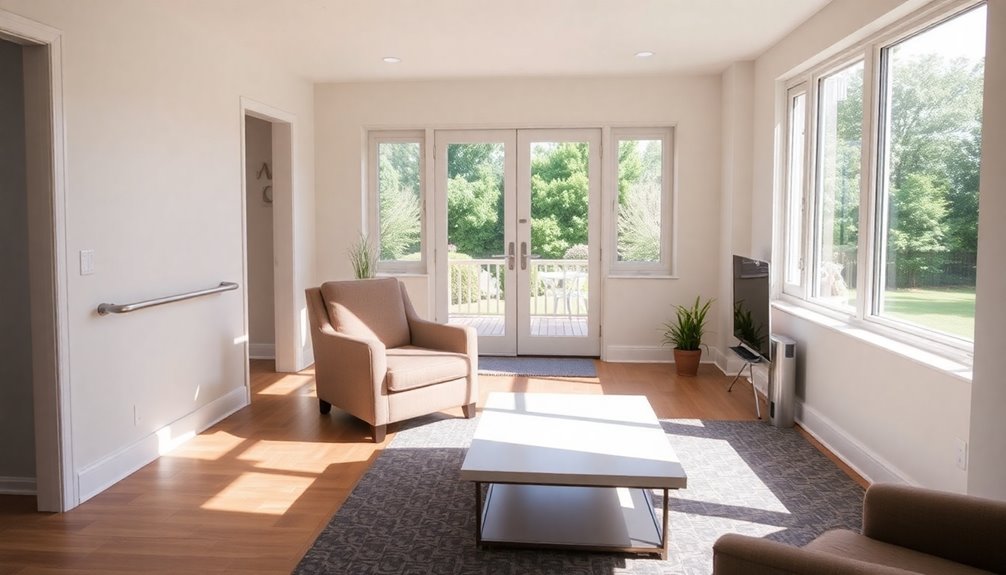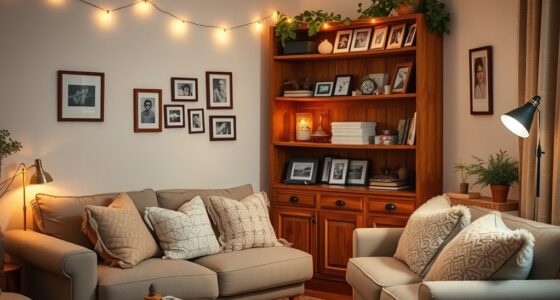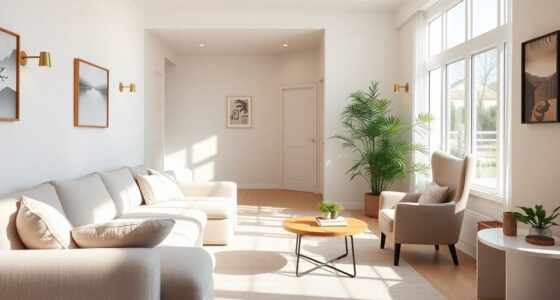To enhance senior mobility and accessibility, focus on adopting accessible design principles like wide doorways, clear pathways, and non-slip flooring. Prioritize proper lighting with strategically placed fixtures and night lights to prevent falls. Choose ergonomic, lightweight furniture, and consider bathroom modifications like grab bars and hobless showers. Also, select adjustable kitchen features and incorporate technology for safety. These strategies can greatly improve comfort and independence in the home—keep exploring for more ideas to elevate your space!
Key Takeaways
- Ensure doorways are at least 32 inches wide and maintain clear pathways of 36 inches for easy mobility aid access.
- Install grab bars in bathrooms and stairways to provide support and enhance safety for seniors.
- Use non-slip flooring and secure area rugs to minimize tripping hazards in high-traffic areas.
- Incorporate adequate lighting with motion sensors to improve visibility and navigation, especially at night.
- Choose ergonomic and lightweight furniture, allowing easy movement and comfort for seniors.
Importance of Accessible Design for Seniors
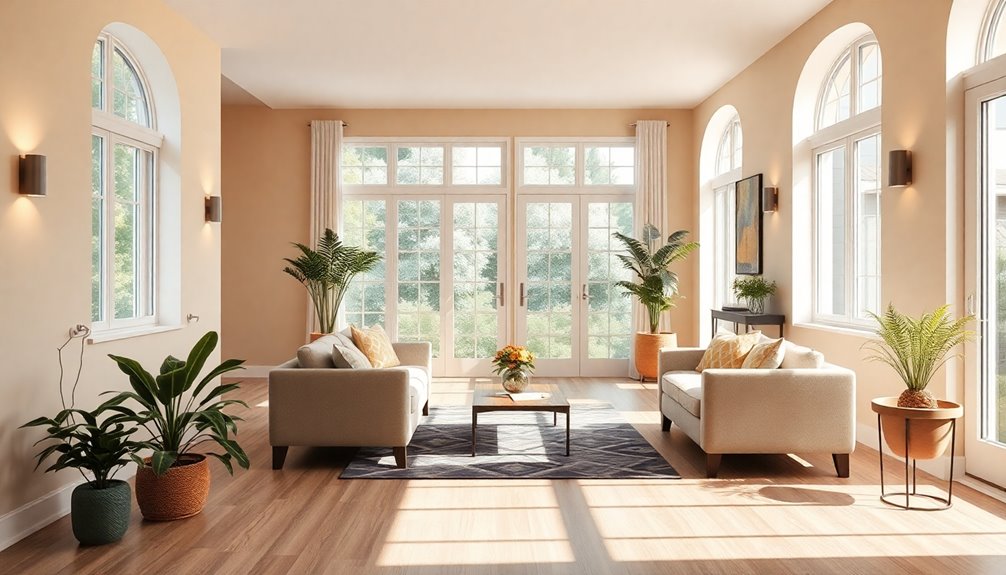
As you consider the importance of accessible design for seniors, keep in mind that it can dramatically enhance their independence and mobility.
By incorporating features like step-free entrances and wider doorways, you create safer living environments that reduce the risk of falls. This not only boosts safety but also improves their overall quality of life.
Planning for accessible design during home design can save you money, as retrofitting later costs about 22% more.
Remember, over 50% of the population benefits from liveable design, enhancing usability for everyone.
Investing in accessible features can also increase property value and demand, making it a smart choice for homeowners looking to enhance both their space and community well-being. Additionally, understanding filial responsibility laws can help families plan financially for future care needs.
Key Mobility and Accessibility Considerations

When designing a space for seniors, prioritizing mobility and accessibility is essential to guarantee they can navigate their homes safely and comfortably.
Start by ensuring wide doorways of at least 32 inches, allowing easy access for walkers and wheelchairs. Clear pathways free from clutter are important for reducing the risk of tripping and preventing falls.
Consider installing ramps or stairlifts to enhance accessibility between levels. Additionally, strategically placed grab bars in bathrooms and along stairways provide critical support and balance.
Lowering countertops, sinks, and cabinets makes these spaces more user-friendly, promoting independence.
Safe and Functional Space Planning
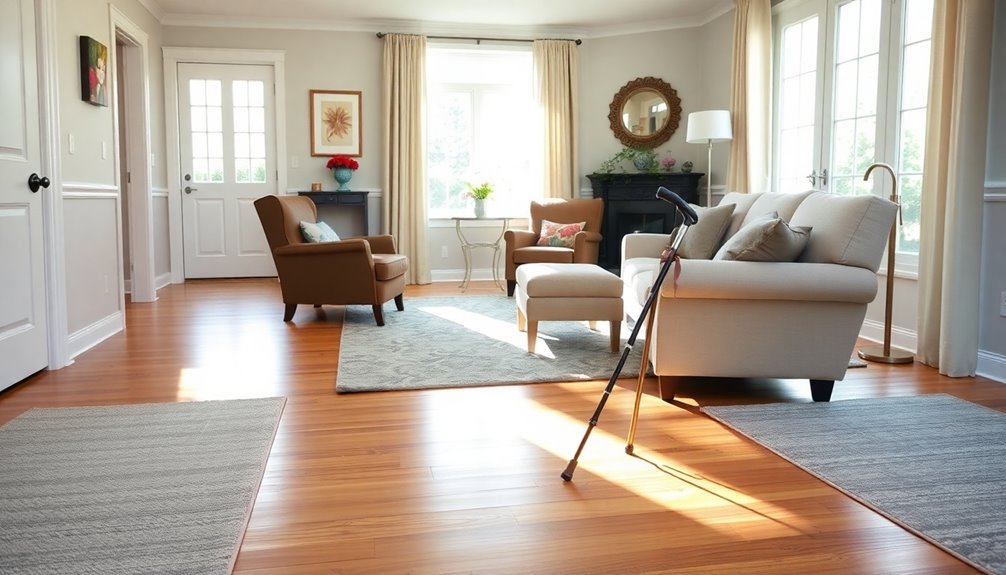
When planning your space, prioritize clear pathways that allow easy movement for mobility aids like walkers and wheelchairs.
Keep furniture arranged to create an unobstructed flow, making it easy to access frequently used items without strain.
Clear Pathways for Mobility
To guarantee seniors can move safely and confidently through their homes, it is crucial to create clear pathways that accommodate mobility aids like wheelchairs and walkers. Ensure these pathways are at least 36 inches wide for easy navigation. Prioritize unobstructed flow by avoiding overcrowded spaces with excessive furniture or decor, which can create hazards. Use non-slip flooring materials to reduce tripping risks and enhance stability in high-traffic areas. Additionally, strategically place furniture for clear sightlines, helping seniors navigate safely through their environment. Implementing non-slip flooring options can significantly boost safety and comfort in a senior's living space.
| Strategy | Details |
|---|---|
| Clear Pathways | Minimum 36 inches wide for mobility aids |
| Unobstructed Flow | Avoid overcrowding and tight spaces |
| Non-slip Flooring | Use materials that enhance stability |
| Tripping Risks | Secure area rugs to minimize hazards |
| Sightlines | Arrange furniture for easy navigation |
Furniture Arrangement Optimization
Optimizing furniture arrangement is essential for creating a safe and functional living space for seniors. Focus on these strategies to enhance mobility and accessibility:
- Prioritize clear pathways by keeping furniture organized and minimizing clutter.
- Guarantee wide doorways (at least 32 inches) for easy navigation with mobility aids.
- Use multi-functional furniture, like ottomans with storage, to maximize space efficiency.
- Incorporate non-slip flooring materials to prevent falls and enhance safety.
Additionally, position frequently used items within easy reach to promote independence.
Remember to install adequate lighting throughout the space, especially in hallways and near furniture arrangements, to improve visibility. Furthermore, creating an organized environment can reduce stress levels and promote a sense of calm, which is particularly beneficial for seniors.
Choosing Senior-Friendly Furniture
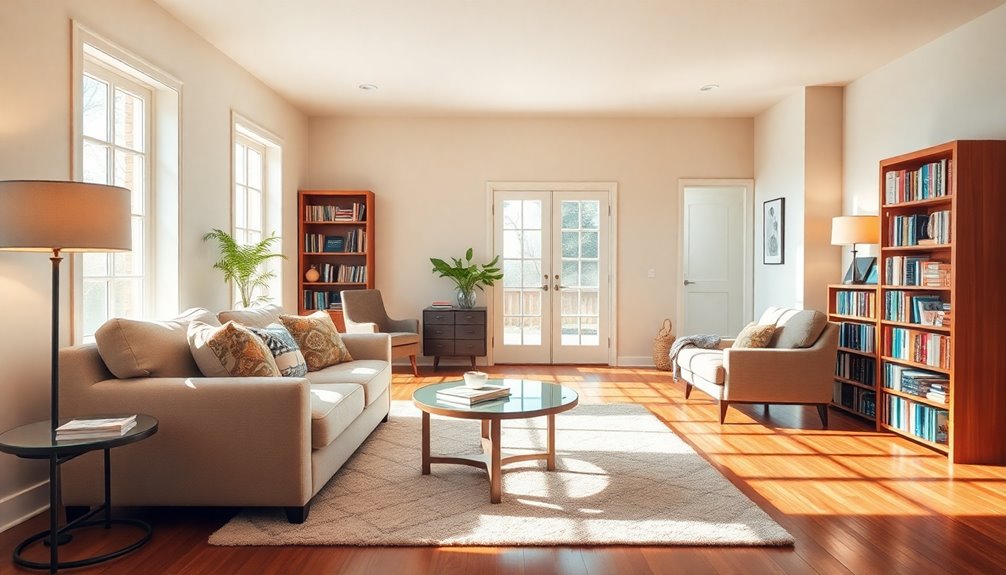
When selecting furniture for seniors, focus on ergonomic chairs that provide lumbar support and armrests to make sitting and standing easier. Consider adjustable bed options that cater to different sleeping preferences while promoting independence. Finally, accessible storage solutions can help minimize strain, ensuring that everything is within reach. Additionally, incorporating inflation-protected annuities can offer financial stability, ensuring seniors can afford necessary modifications to their living spaces as they age.
Ergonomic Chair Selection
Choosing the right ergonomic chair is essential for enhancing comfort and mobility for seniors, as it directly impacts their daily activities.
When selecting ergonomic chairs, consider features that address mobility issues while providing proper support:
- Armrests for easier sitting and standing, improving ease of use
- Firm cushions for better support, making it easier to rise from seated positions
- Adjustable-height options to accommodate various body types and preferences
- Lightweight chairs for easy movement and rearrangement
Additionally, selecting chairs that provide proper support can significantly enhance overall comfort and mobility, allowing seniors to maintain their independence.
Adjustable Bed Options
Adjustable bed options can greatly enhance comfort and mobility for seniors, making it easier for you to find the perfect sleeping position.
These adjustable beds allow you to customize your sleeping position, improving ease of getting in and out of bed while reducing the risk of strain on your joints.
Many models feature ergonomic designs that support proper spinal alignment, promoting better rest and enhancing safety.
Additional features like massage functions can alleviate muscle tension and improve circulation, especially beneficial for those with mobility issues.
Plus, easy-to-use remote controls foster independence, allowing you to adjust settings without assistance.
Incorporating smart toilet innovations can also contribute to a more accessible bathroom environment for seniors, enhancing their overall comfort and safety.
Accessible Storage Solutions
Creating a comfortable living space for seniors goes beyond just selecting the right bed; accessible storage solutions are just as important.
You'll want to focus on easy-to-reach storage options that minimize strain. Consider incorporating:
- Built-in storage like ottomans for dual functionality.
- Open shelving to enhance visibility and accessibility.
- Multi-functional furniture, such as coffee tables with storage compartments.
- Rounded edges on furniture to reduce injury risks.
These elements not only help in organizing personal belongings but also create a safe and inviting environment. Additionally, maintaining a clean home can reduce allergens and pollutants, further enhancing the overall well-being of seniors in their living space.
Importance of Proper Lighting

Proper lighting plays an essential role in ensuring the safety and comfort of seniors at home. Adequate lighting reduces the risk of trips and falls, making well-lit environments critical.
By strategically placing lamps and fixtures in high-traffic areas, you can enhance visibility, allowing for safe navigation throughout the home.
Don't forget to maximize natural light, as it not only brightens spaces but also boosts mood and well-being.
Installing night lights in hallways and bathrooms is imperative to prevent accidents during nighttime trips, giving reassurance to seniors who may move around after dark.
Consistent lighting throughout the home, especially in kitchens and reading areas, considerably contributes to both safety and comfort for older adults.
Bathroom Modifications for Enhanced Safety

When it comes to enhancing safety in the bathroom, making thoughtful modifications can make a world of difference for seniors.
Implementing these bathroom modifications not only enhances safety but also greatly reduces the risk of accidents:
- Install grab bars near toilets and in showers for stable support.
- Use non-slip mats in showers and beside bathtubs to prevent slips.
- Consider hobless showers to eliminate tripping hazards.
- Add raised toilet seats to minimize the distance seniors need to lower themselves.
Incorporating shower seats allows for seated bathing, reducing fatigue and offering a comfortable experience. Additionally, ensuring proper venting techniques during any remodeling can help maintain air quality and safety in the bathroom environment.
Kitchen Design for Accessibility
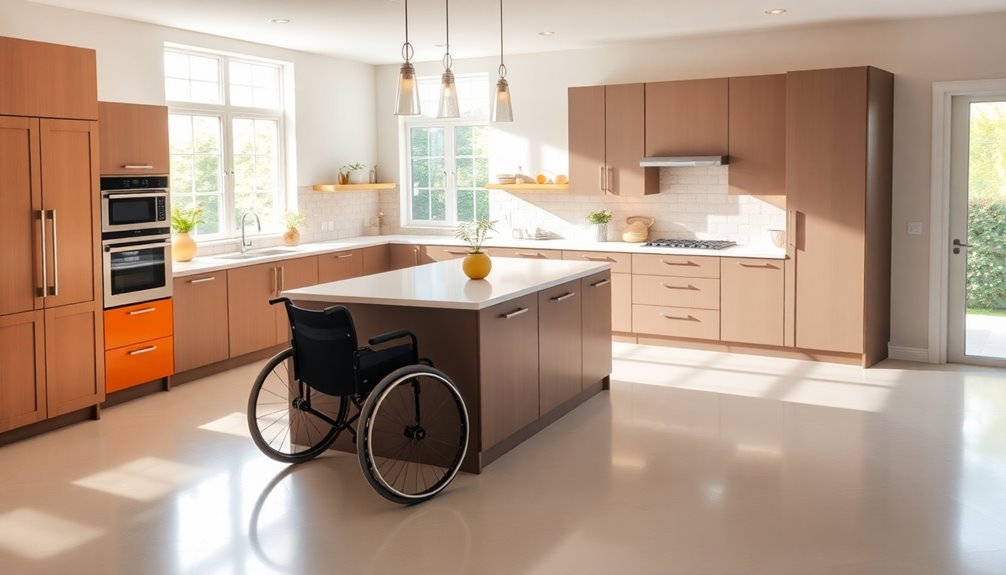
To guarantee your kitchen meets the needs of seniors, focusing on accessibility is key. Implement adjustable sink heights and shallow sinks to reduce strain when washing dishes or preparing food.
Incorporating hands-free faucets and pull-out pantries can enhance functionality, minimizing the need for bending or stretching. Opt for storage solutions like refrigerator door compartments and front-mounted controls on cooktops to improve accessibility and ease of use for those with mobility limitations.
Make certain to choose countertops with round edges to prevent injuries, creating a safer cooking environment.
Finally, install under-cabinet lighting to guarantee well-lit workspaces, reducing the risk of accidents during meal preparation.
These strategies will help create a kitchen that's both practical and safe for seniors.
Flooring Choices to Prevent Falls
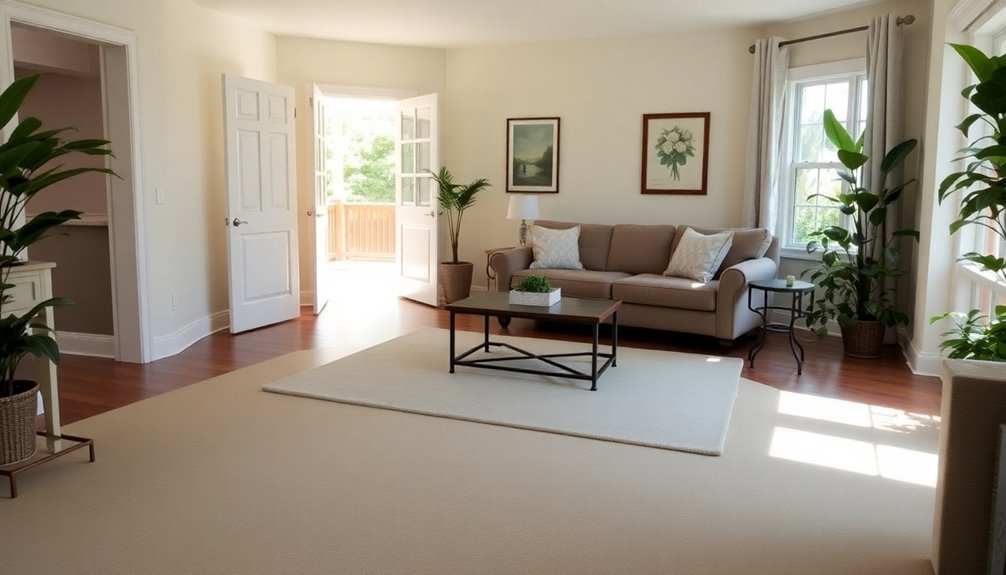
Choosing the right flooring is vital for creating a safe environment that minimizes the risk of falls among seniors. When selecting flooring choices, consider these strategies to help prevent falls for seniors at home:
- Opt for slip-resistant flooring materials like low-pile carpets, vinyl, or hardwood with a non-slip finish.
- Avoid thick carpets and loose area rugs to eliminate tripping hazards.
- Guarantee smooth, even surfaces to facilitate the use of mobility aids like walkers and wheelchairs.
- Use contrasting colors between flooring and walls to enhance depth perception.
Regular maintenance is also important, as worn or damaged surfaces can create additional tripping hazards.
Integrating Technology for Improved Safety
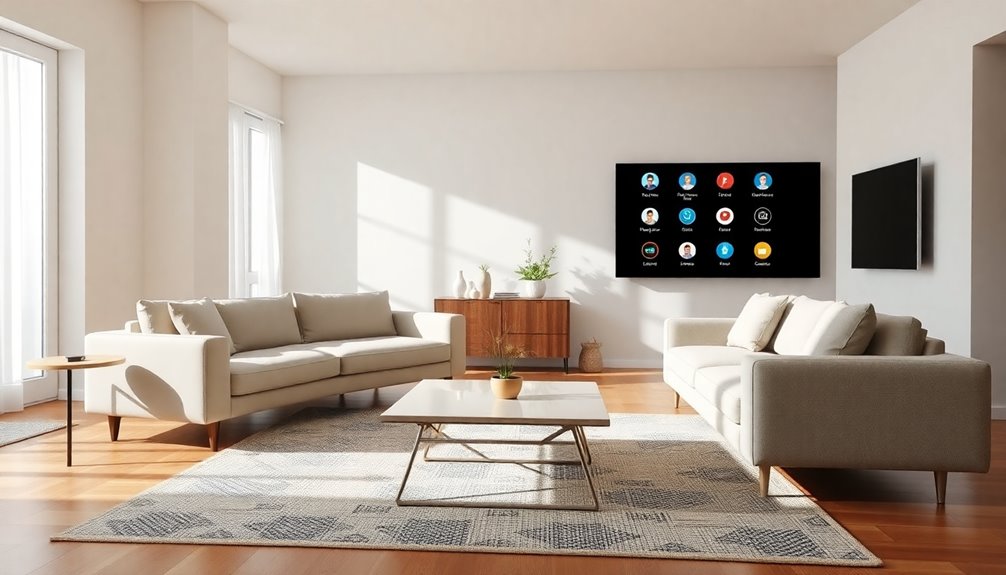
Creating a safe environment for seniors goes beyond careful flooring choices; integrating technology can greatly enhance safety and independence.
Smart home devices, like motion sensors, alert you to movement, reducing the risk of falls. Video doorbells let you see and speak to visitors without opening the door, improving security and peace of mind.
Emergency alert systems allow you to quickly call for help when needed, fostering independence while ensuring immediate assistance in emergencies. Smart thermostats maintain a comfortable living environment by adjusting temperatures automatically, essential for well-being.
Plus, voice-activated assistants enable you to control various home features hands-free, enhancing accessibility and convenience. Additionally, incorporating air purification systems can improve indoor air quality, further supporting the health and well-being of seniors.
Embracing these technologies creates a safer, more comfortable space for seniors.
Personalizing Spaces for Comfort and Security
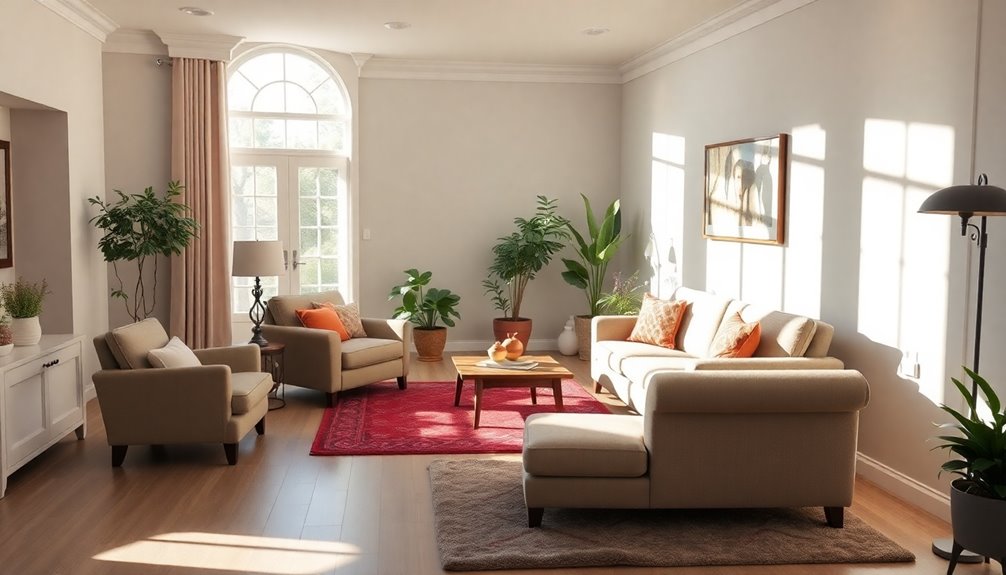
When you personalize spaces for seniors, you not only enhance their comfort but also foster a greater sense of security. A comfortable home for seniors includes thoughtful touches that promote emotional well-being and safety. By incorporating warm color palettes and soft furnishings, you create an inviting atmosphere that encourages relaxation.
Consider these strategies:
- Use adjustable furniture with proper lumbar support to enhance accessibility and comfort.
- Implement easy-to-reach storage solutions like lowered cabinets to minimize strain.
- Add personal elements such as family photos to strengthen identity and connection.
- Ascertain pathways are clear to promote safety and ease of movement.
Incorporating natural materials like wood can also enhance the aesthetic and create a warm environment.
These personalized adjustments make a significant difference in their daily lives, helping them feel secure and at home.
Frequently Asked Questions
What Is Accessibility in Interior Design?
Accessibility in interior design means creating spaces that everyone can navigate easily, regardless of their mobility or sensory needs.
You'll want to focus on features like wider doorways and clear pathways to accommodate walkers and wheelchairs.
Incorporating elements like grab bars, adjustable furniture, and non-slip flooring boosts safety and functionality.
Prioritizing natural light and intuitive layouts makes your space more comfortable and usable for individuals of all ages and abilities, enhancing overall living quality.
How to Design a Room for the Elderly?
When you design a room for the elderly, prioritize their safety and comfort.
Start by ensuring doorways are wide enough for mobility aids, like wheelchairs or walkers.
Arrange furniture to create clear pathways, avoiding clutter that could lead to falls.
Choose non-slip flooring materials and install adjustable lighting for better visibility.
Finally, incorporate grab bars and handrails in key areas to provide essential support as they navigate the space.
How to Design a House for Seniors?
When designing a house for seniors, you should prioritize wide doorways and clear pathways to guarantee easy movement.
Incorporate grab bars in bathrooms and stairways for added safety.
Use adjustable furniture to enhance comfort and independence.
Implement effective lighting solutions, like night lights, for better visibility.
Finally, opt for an open floor plan and minimize clutter, creating a safe space where seniors can navigate freely without obstacles.
How to Design for Elderly People?
When you design for elderly people, focus on creating a comfortable, safe, and accessible environment.
Start by using an open floor plan with wide pathways to avoid obstacles. Incorporate grab bars and non-slip surfaces in key areas like bathrooms.
Guarantee there's plenty of lighting to enhance visibility and reduce hazards. Choose furniture that offers support, like chairs with armrests.
Finally, consider features like walk-in showers and raised toilets to accommodate mobility needs effectively.
Conclusion
By embracing these interior design strategies, you can create a home that not only enhances mobility but also fosters independence. Prioritize accessibility, choose supportive furniture, and guarantee proper lighting. Focus on safe flooring and functional space planning, while integrating technology for added security. Personalize your spaces to reflect comfort and joy. Ultimately, you're not just designing a home; you're crafting an environment that empowers seniors to thrive, enjoy life, and feel truly at ease.
